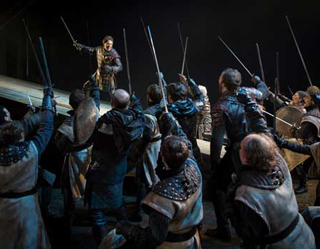
For a play whose plot centers on one of English history's most decisive military campaigns in one of its longest wars, Shakespeare's Henry V is curiously short on violence, being more concerned with lessons in how to fight a war—and by extension, how to govern a country.
Oh, but who cares about the political situation precipitating the showdown—those old-time royals were always fighting over something, and anyway, didn't Joan of Arc kick the Brits out of France a few years later? No, what we want is to see a rookie commander and his pack of scrappy bro's kick the butts of effete bullies who think their superior numbers guarantee them victory.
Besides, what's the use of a stage as big as Chicago Shakespeare's without a noisy alarums-and-excursions brawl? Its preamble, involving a towering castle wall that, literally, collapses to provide access for attacking troops, was choreographed by director Christopher Luscombe, but the thrilling battle of Agincourt was left entirely to combat designer Matt Hawkins.
"Chris told me he wanted us to be aware of the chaos of the battle, and of Henry—unlike most kings—fighting on the front lines, side by side with his men," explains Hawkins, "This is why we shift from real-speed to slow-motion [a technique called "bullet time"] during the initial confrontation. Otherwise everything would happen so fast that spectators wouldn't be able to distinguish Henry from the other soldiers."
Most people don't know that longbows—which could be reloaded much more quickly than the old-fashioned crossbows—were the secret weapon that won the war for the English. With the assistance of sound coordinator Lindsay Jones, however, Hawkins highlights their appearance with all the suspense of an action-movie: first we hear menacing bass-heavy music, then the line of archers take their positions high up on the bridge, turning slowly downstage to loose their bowstrings, bringing forth a chorus of screams, presumably those of the surprised enemy.
What the more tender-hearted playgoers are likely to remember, though, is the untimely death of a young squire barely into his teens. The script has Captain Fluellen reporting to his commander that even the servants have been slaughtered, but Hawkins stages this atrocity in full view of a horrified audience, who watch as the unarmed lad is ambushed by no less than three French mercenaries, each inflicting a dagger thrust on their victim before leaving his bleeding body to be found by his comrades.
"Kevin Quinn, who plays the boy, had done Lord of the Flies at Steppenwolf," Hawkins grins, "so when Chris asked me if I could kill the kid, I said yes."
Hawkins considers the most difficult part of staging such a large and complicated scrimmage "having so many sword points really close to the front row—but that's my fault for wanting so many people in the scene. We also have lots of actors covering multiple roles, making it hard at understudy rehearsals to keep track of who's playing what on any particular night." He smiles sheepishly, "Nick Harazin, our fight captain, and I both partner the actors to get everyone up to speed, but with so many individual fights, sometimes I forget my own choreography. When that happens, we all have to go back and review the whole sequence on video."
Henry V runs at Chicago Shakespeare Theatre through June 15
Mary Shen Barnidge
Contributing Writer

 Follow Us On Twitter
Follow Us On Twitter